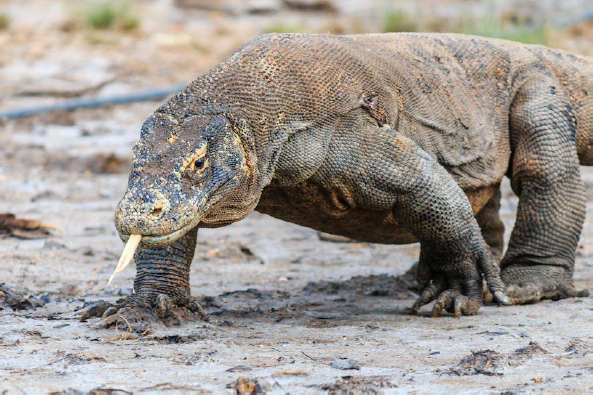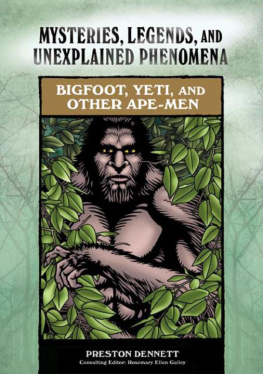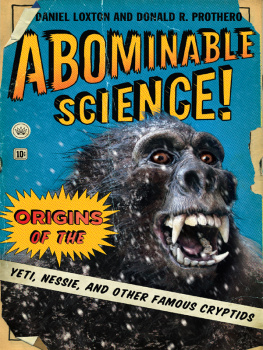
HUNTING MONSTERS:
CRYPTOZOOLOGY AND THE REALITY BEHIND THE MYTHS
DARREN NAISH
Introduction
The Loch Ness monster, bigfoot and the yeti are among the most familiar icons of modern popular culture. Millions of people worldwide have heard of these alleged creatures, and many have gone to the trouble of learning about them. The extraordinary popularity of these mystery creatures often termed cryptids is obvious from the huge number of books, magazine articles, TV shows and movies devoted to them. These superstar cryptids are so popular, so familiar, that a major portion of interest in world mysteries, in the paranormal and the unexplained is driven specifically by the curiosity that surrounds them. In other words, its partly thanks to an interest in the Loch Ness monster, bigfoot and so on that such subjects as UFOs, ghosts, reincarnation and telekinesis get the widespread coverage that they do. Cryptids tend to be lumped in with these other subjects, and thus have a bad reputation among scientists and other critical thinkers.

The Loch Ness monster, known as Nessie, is one of the worlds most popular cultural icons and has been ever since the 1930s. Over the years, an enormous amount of money has been generated from Nessie-based tourism, books, toys, merchandise, movies and TV shows. This image shows the famous Surgeons photo or Wilson photo.
On the other hand, the idea that these creatures might really exist inspires many people to think about the reliability of eyewitness evidence as a source of information, and to consider seriously how cryptids might make sense as living, breeding, breathing creatures. The Loch Ness monster, the yeti and so on can introduce people to a broader interest in critical thinking, a scientific view of the world and a curiosity about the natural world and how we interpret it. Seen from this point of view, cryptids might not be a bad thing at all.
Throughout history, people claim to have seen or heard of unusual, often monstrous creatures. Cryptids dont match the animals accepted as real by scientists, and mainstream scientific opinion is that they very probably dont exist. But a dedicated and specialized community of researchers have sought to overturn this view. These people have collected great quantities of eyewitness data pertaining to cryptids and have also come up with a great number of ideas about the sorts of creatures these cryptids might really be, about how they live and behave and about their evolutionary history.
This entire field of research is termed cryptozoology and in this book well look at a number of classic target creatures of the field in a critical fashion. One aim of this book is to work out how these alleged creatures are best interpreted. Do they really represent unknown creatures, or can we provide better explanations for their alleged existence? A second aim is to look at why theyve been imagined or depicted in the way that they have.
Chapter 1 - What is Cryptozoology?
Well start with a quick history. As well see throughout this book, the idea that there might exist a number of large, mysterious creatures monsters has been present throughout recorded history. At the beginning of the Renaissance (the 15th and 16th centuries), such monsters as dragons, unicorns, mermaids and giants were not regarded as the products of myth or fairytale, but assumed to be flesh and blood creatures awaiting discovery and documentation.

Today, we supposedly have a clear idea as to which creatures are real and which are imaginary or mythical. This boundary was less obvious in the past. Animals like dragons were said or implied to be real, sometimes living in remote places or far-off lands. Relics of their existence were discussed and even displayed in collections of curiosities. People might have given up on the existence of dragons today, but uncertainty about the existence of monsters has never really gone away.
As the centuries passed and knowledge improved, views changed as to which creatures most likely existed and which did not. During the 17th and 18th centuries, unicorns, mermaids and dragons came to be regarded as having been based on confused or exaggerated descriptions of more familiar animals, like antelopes, seals, manatees, lizards, crocodiles and great snakes. And so they ended up disappearing from books and manuscripts on natural history and biology. But other mystery creatures remained in limbo. Even by the end of the 19th century there was no firm official opinion on sea monsters, on the water beasts said to lurk in various lakes and rivers, or on more obscure mystery animals like the Queensland tiger of Australia and the hairy, man-like nittaewo of Sri Lanka.
Even if we consider the scientific writings of the early 20th century, we see that learnt people continued to ponder the existence of such creatures. New animals some of which were surprisingly large were still being found in many regions of the world, meaning that the existence of such mystery creatures remained a possibility. Gorillas were only officially discovered during the mid 1800s and early 1900s, meaning that the possible existence of gorilla-sized primates elsewhere in the world was by no means dismissed out of hand. The discovery of the Komodo dragon Varanus komodoensis in Indonesia in 1912 meant that the existence of other large, undiscovered reptile species also remained plausible.

The several different gorilla species and subspecies are relative latecomers to the zoological scene: the Western lowland gorilla, shown here, was only discovered in the 1840s. However, the 19th century discovery of a giant primate in tropical Africa does not provide strong support for the idea that undiscovered giant primates might also exist, today, in North America.
An important point that emerges from this quick review is that theres never been a time in history when scientists as a whole denounced all interest or belief in mystery creatures. People interested in animals have always been aware of stories about mystery or legendary creatures, and right up into modern times have also written about such creatures and gone in search of them. Indeed, there is still today a reasonable amount of mainstream engagement in discussions about mystery creatures. And as well see throughout this book, there remain a number of qualified, scientifically trained researchers and writers who still endorse the existence of a diverse array of mystery beasts. Notably, however, the number and diversity of these mystery creatures has reduced over time, as has the number of endorsers. This is a key theme that well revisit later.

The worlds largest living lizard the Komodo dragon was officially discovered in 1912. Its discovery helped fuel the idea, popular among cryptozoologists even today, that giant reptiles might await recognition elsewhere in the world. The notion that the Komodo dragon is some kind of holdover of ancient times is not accurate. It is no more anachronistic than the vast majority of other living animals.
Next page

















